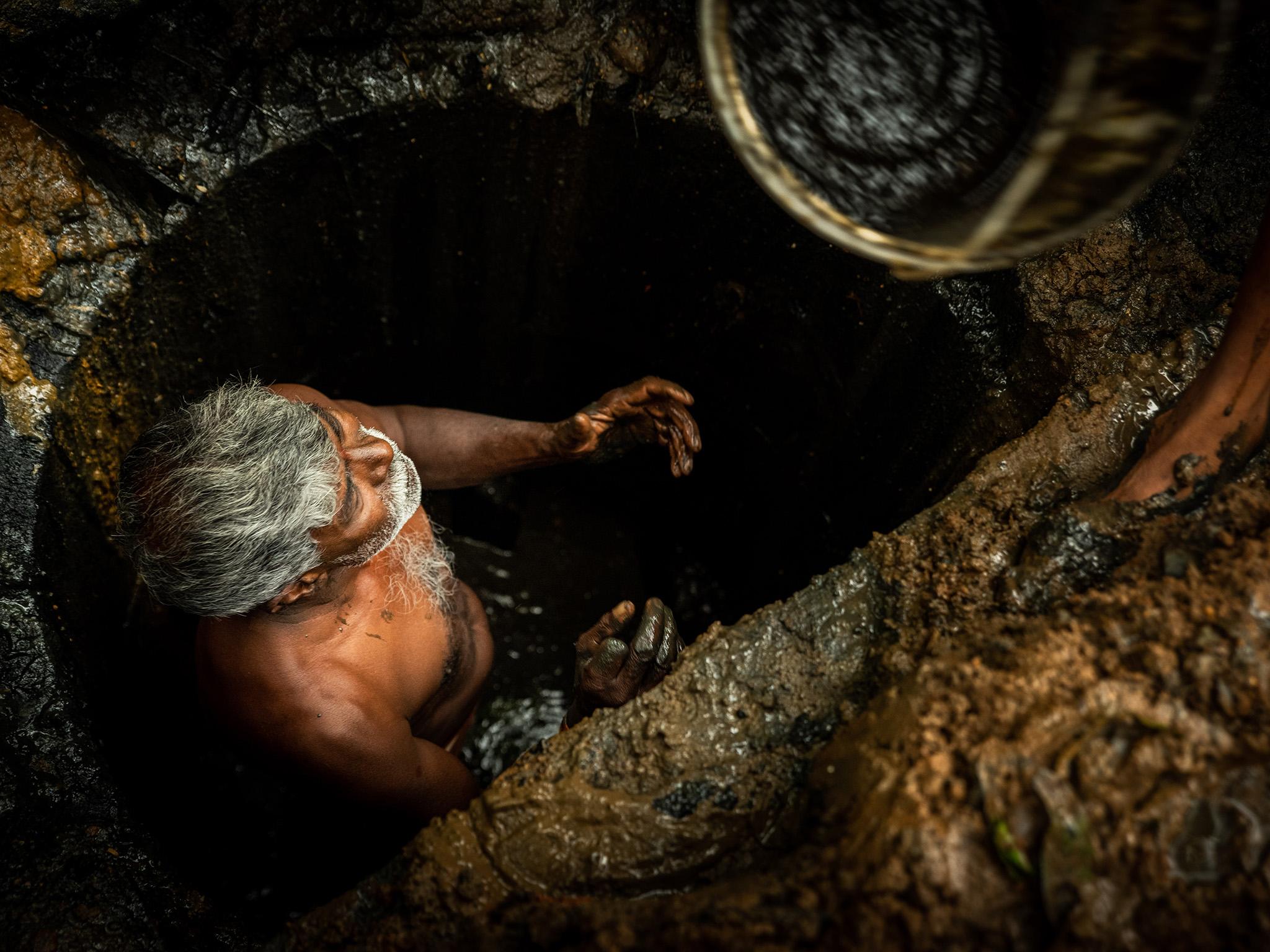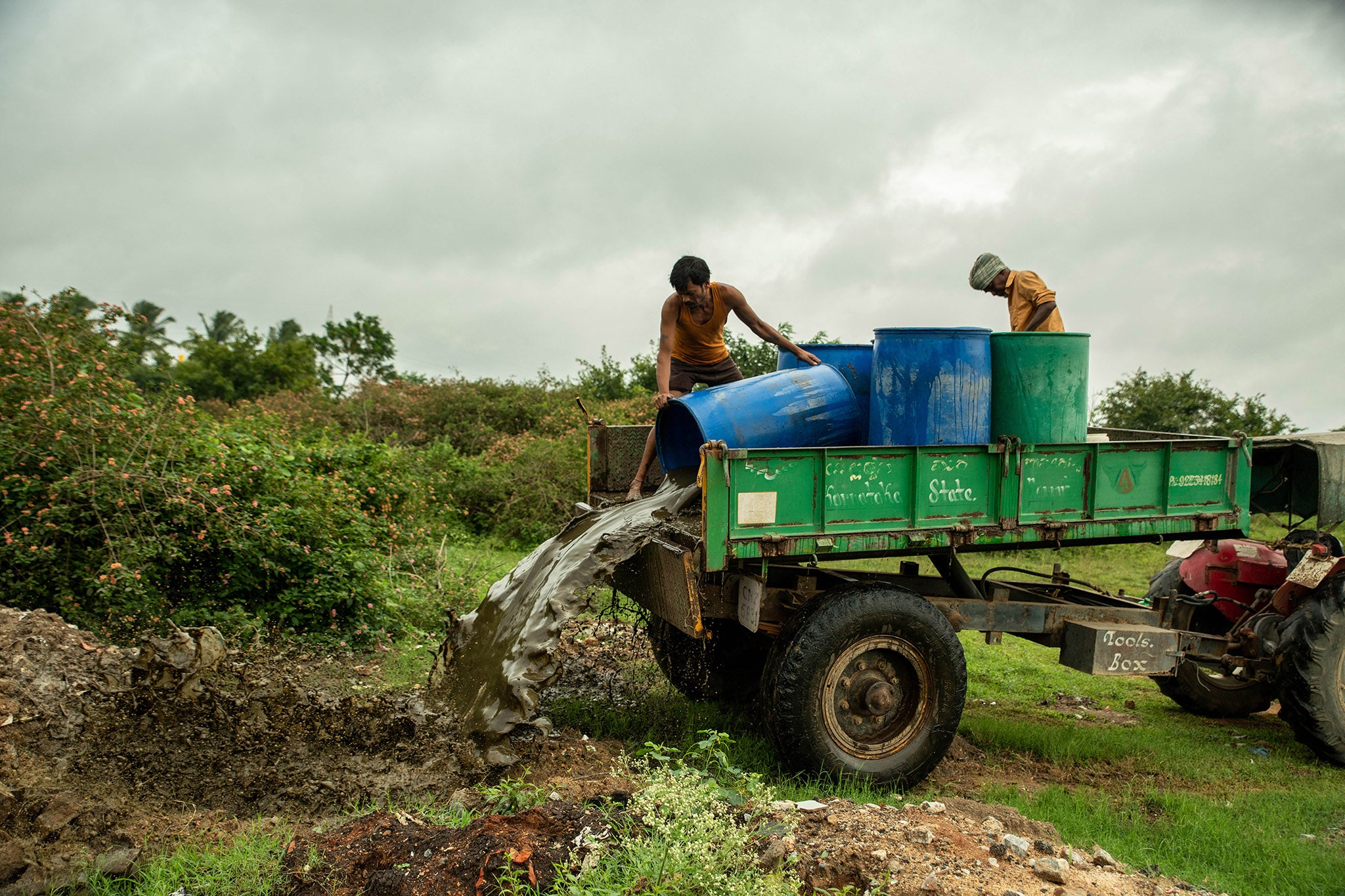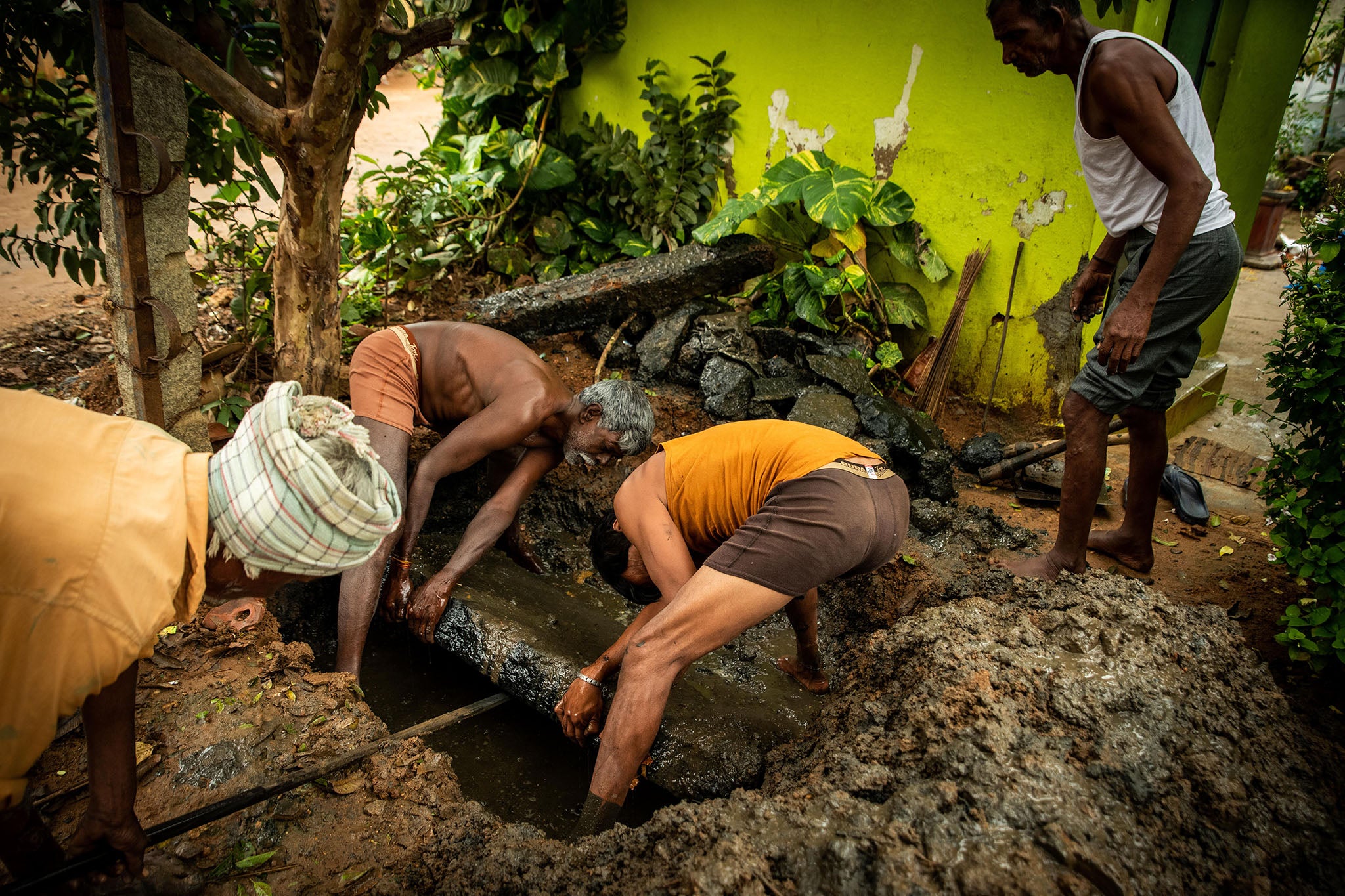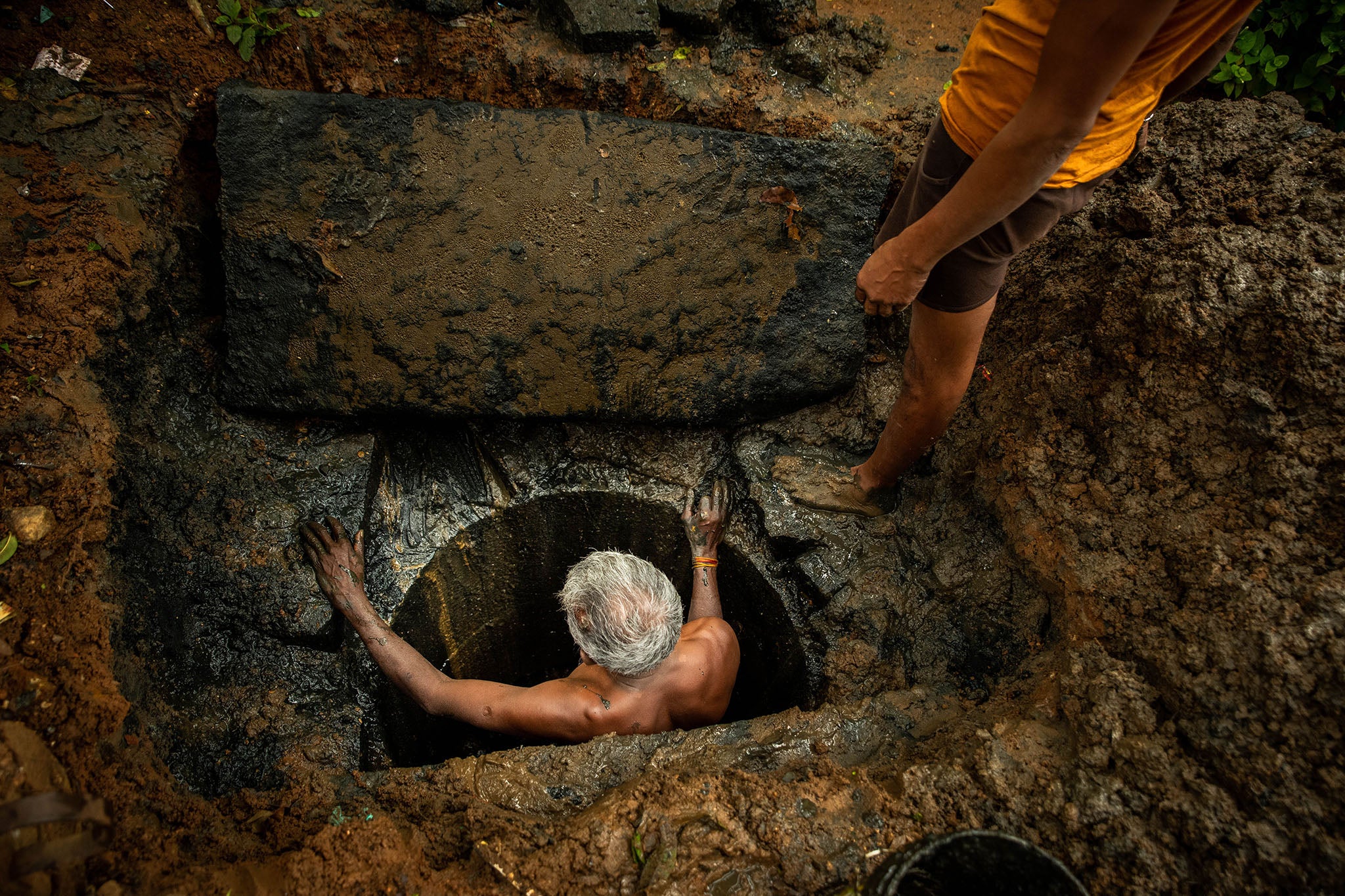Despite Modi’s cleanliness drive, many still struggle in India’s sewers
The number of people with access to toilets has increased dramatically since 2014, but it has made little difference for those workers who toil in foul conditions. Joanna Slater reports

Your support helps us to tell the story
From reproductive rights to climate change to Big Tech, The Independent is on the ground when the story is developing. Whether it's investigating the financials of Elon Musk's pro-Trump PAC or producing our latest documentary, 'The A Word', which shines a light on the American women fighting for reproductive rights, we know how important it is to parse out the facts from the messaging.
At such a critical moment in US history, we need reporters on the ground. Your donation allows us to keep sending journalists to speak to both sides of the story.
The Independent is trusted by Americans across the entire political spectrum. And unlike many other quality news outlets, we choose not to lock Americans out of our reporting and analysis with paywalls. We believe quality journalism should be available to everyone, paid for by those who can afford it.
Your support makes all the difference.The sun is climbing in the Bangalore morning sky as a man in his late fifties strips to his underwear and prepares to lower himself into a pit of sewage.
Kaverappa looks down into the shaft behind a house on the southern rim of India’s technology capital. Then he hooks his fingers and toes into grooves in the concrete pit, 10 feet deep, and begins to descend.
A foul, sulphurous smell floats up. Soon his legs, arms, chest and shoulders are coated with near-black fluid, the product of a year’s worth of toilet waste.
Such work – emptying septic tanks and sewers by hand – is both dangerous and illegal in India. But for Kaverappa, who goes by only one name, it is an ordinary day. He wants to leave the job behind but feels there is no alternative. “We don’t have anything else,” he says.
Indian prime minister Narendra Modi has received international plaudits for his campaign to build millions of toilets across the country. But the cleanliness drive has failed to eliminate the country’s most stigmatised and hazardous sanitation work: dealing with human waste by hand.
Some families have done this work for generations, and others are dependent on it to survive
Even in Bangalore, an expanding metropolis that is home to software giants and multinational firms, deaths of sewer workers occur with depressing regularity. At least three people have died cleaning sewers in the city since March; across India, activists have documented 112 such deaths this year, more than one every three days.
Despite a 2013 law forbidding the practice, cleaning sewers and removing blockages is still done by hand and without any safety equipment in many parts of the country. Employers who violate the law are not punished.
Modi’s cleanliness drive has scored key victories: The number of people with access to toilets has increased dramatically since 2014. But the race to celebrate progress has obscured crucial gaps. For instance, a survey carried out by India’s national statistical body revealed that a quarter of rural Indians still do not have yet access to toilets, contrary to the government’s claims.

What’s more, the toilet-building drive is creating its own challenges, experts say. Many of the toilets built in the campaign are in rural areas with no sewage systems. A large percentage of the toilets are connected to basic holding pits that do not convert waste into fertiliser, according to VR Raman, the head of policy at WaterAid India, a nonprofit organisation that works to improve access to clean water. Such pits will require emptying. “You can imagine on whom the society is going to depend [for that work]”, he says.
Kaverappa, a small, wiry man who goes barefoot everywhere, has experienced this dynamic first-hand. More than 15 years ago, as Bangalore was expanding, more and more houses were built on the city’s southern periphery. Where there were houses, there were toilet pits to clean. Someone in the neighbourhood came to Kaverappa and asked if he could empty the pits – not because he had done the work before, but because he is Dalit, the community formerly known as “untouchables”.
“This occupation is a caste-based occupation all over India,” says K Obalesh, the founder of an organisation started in 2005 that works to eradicate manual scavenging – the practice of dealing with human waste by hand without protective gear, whether in dry latrines, holding pits, sewers or septic tanks.
Some families have done this work for generations, and others are dependent on it to survive, Obalesh says. The general attitude among state and local authorities is one of “acute negligence” he adds. “They’re not interested in implementing [rehabilitation] schemes and breaking the cycle.”

There is no comprehensive count of how many workers engage in manual scavenging in India. The government recently carried out a survey in a quarter of India’s districts and found at least 40,000. But such figures understate the scope of the problem, activists say. Obalesh estimates that there are 20,000 such workers in the state of Karnataka alone.
A few cities are starting to introduce technology in an attempt to end the practice. In Delhi, local authorities have procured more than 200 trucks with specially designed jets and rods to eliminate the need for humans to enter sewers.
But some of the drains and sewers in the country are so old – or located in such narrow lanes – that “no machinery fits that purpose”, according to Nirat Bhatnagar, a partner at Dalberg Advisors, a development consulting firm.
It will take far more than building toilets to solve such sanitation challenges
Meanwhile, it will take far more than building toilets to solve such sanitation challenges. Bezwada Wilson, a prominent activist who heads an organisation called the Sanitation Workers Movement, calls the government’s approach “madness”. They are “constructing toilets, but they have not developed the infrastructure for where the human excreta will go and how this is getting emptied”, he says.
Muttaiah, 63, a social worker in Bangalore who goes by only one name, says he was on his motorbike when he saw one man standing above a manhole and another inside it. He says the man inside the stinking manhole was working without any safety equipment – no gloves, no shoes, no supplemental oxygen. The men told Muttaiah that a local contractor hired by a city engineer had paid them to clean the sewer. Muttaiah took photos and videos and went to the police to file a complaint. “If there are convictions and somebody is punished, it will be a strong message to the society,” he says.

E Vishwanath, the chief engineer for solid waste management with the Bangalore city government, disputes such reports. “We have supplied all the safety equipment,” he says, although some workers “may not be using it”.
The law entitles manual scavengers to a one-time rehabilitation payment and a loan to help them transition to a new profession. In practice, however, such benefits are difficult to access. Kaverappa knows what he would do if he was given a loan: buy a tanker truck with suction hoses that would allow him to get out of the pit.
When asked what equipment he uses now, Kaverappa holds out his two hands. Like his father before him, he has been a manual labourer all his life. His earliest memories are of working: he began breaking stones to use in construction and road-building from the age of seven. “How could I go to school?” he asks. “If I go to school, then there would be nothing to eat at home.”
25%
of rural Indians are still without access to toilets
When he was 20, he began loading stones into trucks, together with several other men from the Dalit community. It was backbreaking work from dawn to dusk, and he lost the top of his right index finger in an accident. Kaverappa’s two younger brothers died of tuberculosis and kidney disease before the age of 40. His son died at the age of 17 from a spinal injury that he says doctors never took the time to explain.
Climbing down into pits to empty faecal sludge with nothing more than a bucket was difficult at first, says Kaverappa, especially the smell. Unlike loading trucks full of rocks, however, it is over within a few hours. He earns about $100 a month.
He and two relatives arrive to empty two deep pits full of bubbling waste behind a spacious two-storey home. One of his relatives, who pours the buckets of waste into plastic drums, has been drinking – a common tactic to cope with this type of work. Even as the men are emptying the pit, people inside the home are using the toilet, sending fresh waste cascading into the cylindrical hole.
After the pit is partially empty, Kaverappa clambers down and lifts bucket after bucket of thick waste over his head. When the job is done, he climbs out and stands in the nearby lane, his small frame smeared with muck. Two women walk by in brightly coloured tunics and flowing pants, purses swinging. They do not even glance at him as they pass.
© Washington Post
Join our commenting forum
Join thought-provoking conversations, follow other Independent readers and see their replies
Comments